| By Jim Hutchinson, Jr. The Fisherman from The Fishing Wire 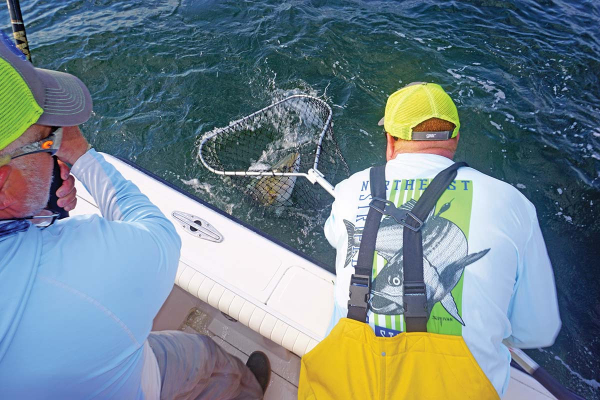 Chuck Many nets a good fish for Dave Glassberg during the spring run off the Jersey Shore during the 2020 Northeast Striped Bass Study. Chuck Many nets a good fish for Dave Glassberg during the spring run off the Jersey Shore during the 2020 Northeast Striped Bass Study.And now there are four! “If one’s an anomaly, and two’s a coincidence, will three or more show a pattern?”That was the lead sentence in our first published piece of this year (Born To Run: Hudson River To Canyon Striper) on the status of our 2019 Northeast Striped Bass Study from our January edition. By now everyone along the Striper Coast is aware of the results; two post-spawn striped bass caught by our research team at The Fisherman, Gray FishTag Research and Navionics in May of 2019, tagged with high-tech MiniPSAT devices to track migration habits during a five-month stretch, ultimately showing returns from the offshore canyons including the Hudson, Block and Veatch.Two $5,000 “pop-off” satellite tags which incorporate light-based geolocation for tracking, time-at-depth histograms for measuring diving behavior, and a profile of depth and temperature, showing two very distinct paths in waters where we typically wouldn’t expect striped bass to swim. There’s been some skepticism of course with some questing whether a big white shark gobbled up these stripers before heading east with a belly full of bass. However, the data stored inside the Wildlife Computers MiniPSAT devices – which amazingly were physically recovered by beachcombers in Massachusetts and New Jersey – shows both tagged fish were alive and swimming along the offshore grounds when the tags detached.We had grand plans in 2020, and with financial support from Navionics, Tsunami Tackle, AFW/HiSeas, Southernmost Apparel and the Recreational Fishing Alliance – on top of the thousands in individual donations from The Fisherman readers, regional advertisers, and local fishing clubs – the Northeast Striped Bass Study was poised to deploy up to a half-dozen MiniPSAT devices this past spring. “The plan was to have multiple boats ready to go at one time, with a full Gray FishTag Research team in New York again during the week of May 18,” said Mike Caruso, publisher of The Fisherman and an advisor for Gray FishTag Research, adding “It was going to be even more groundbreaking than in 2019. ”Due to travel restrictions and the shutdown of Wildlife Computers in Washington State where the devices are built, we missed the height of the post-spawn Hudson River bite by roughly two weeks. But thanks to a determined crew at Gray FishTag Research in Florida and a little improvisation, we hit the Jersey Shore spring run off Sandy Hook with a pair of tags, one deployed Thursday, May 28 and another for the following Wednesday, June 3 while fishing with study supporters David Glassberg and Chuck Many aboard Chuck’s boat, Tyman. The pandemic-related audible paid off with a pair of 46-inch plus stripers, appropriately named Cora and Rona.Tag Return #1 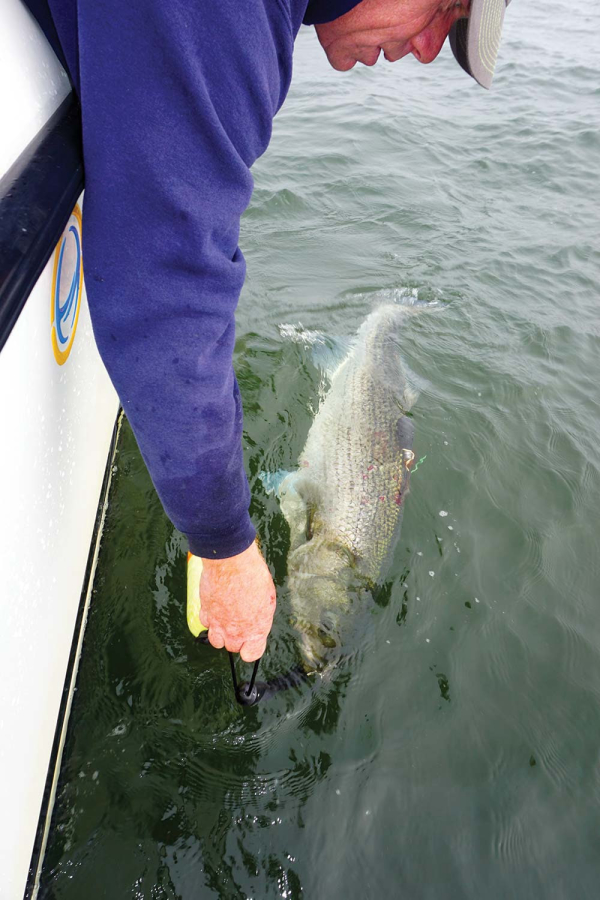 With both a MiniPSAT device and a Gray FishTag Research “streamer” tag, a 46-1/2-inch striped bass called Rona is released back in the waters off Sandy Hook for the start of her tracking adventure.So the $10,000 question we’ve all been waiting to answer with baited breath; where did Cora and Rona eventually get to, and did they follow a similar offshore path to what Freedom and Liberty did during the 2019 study? With both a MiniPSAT device and a Gray FishTag Research “streamer” tag, a 46-1/2-inch striped bass called Rona is released back in the waters off Sandy Hook for the start of her tracking adventure.So the $10,000 question we’ve all been waiting to answer with baited breath; where did Cora and Rona eventually get to, and did they follow a similar offshore path to what Freedom and Liberty did during the 2019 study? Once again – just as in 2019 – our first two tag returns of 2020 reveal two coastal stripers taking a rather incredible journey into depths that few would’ve ever expected from striped bass. On August 1, 2020, the Argos satellite first began to receive information from Cora’s tag in roughly 650 feet of water some 30 miles offshore of Gloucester, MA in an area southeast of Jeffreys Ledge along the Murray Basin. According to the information in the MiniPSAT device since uploaded to the satellites, Cora had spent the previous two weeks heading in an easterly direction toward Stellwagen Bank, traveling approximately 85 miles in 14 days from an offshore area home to the Davis and Rodgers basins in the Gulf of Maine. That big striper was along the west side of George’s Bank for the July Fourth weekend, following a bit of meandering above Hydrographer Canyon.As unbelievable as it may be for some us to believe that final month of travel, the route to actually get to George’s Bank was even more shocking. Cora, a 45-3/4-inch striper tagged on June 3, 2020 off Sandy Hook during the spring run, seemingly took a southeast route soon after her release, following a similar path to overseas freighters coming in and out of New York Harbor using the Hudson Canyon to Ambrose Channel deepwater lanes. By June 10, MiniPSAT data shows Cora down past the Chicken Canyon and not far from the Texas Tower, where she would eventually begin tracking northeast towards Nantucket Shoals over a 14-day period before turning north in between Martha’s Vineyard and Nantucket by June 25.For about three weeks, Cora was outside of 3 miles and essentially unavailable to fishing pressure, and her return inshore in late June didn’t last very long either. During the final days of June Cora had cruised back through Nantucket Shoals before running that final offshore gauntlet in July. Anglers along the south shore of Long Island never got a shot at this 35-pounder. We don’t know where she was in the days leading up to her tagging on June 3, nor do we know where she is now, but we have a pretty solid idea about where she was for 53 days this summer, and it wasn’t near the 3-mile-line along the south shore of Long Island.While Cora was the second big striper tagged for the 2020 Northeast Striped Bass Study – sister Rona being first on May 28 in the same stretch of water 2-1/2 miles east of Sandy Hook – her tag was the first to prematurely pop off. According to Bill Dobbelaer, president of Gray FishTag Research, there are any number of reasons why these highly specialized tags may come free. “That fish could’ve gone under a piece of wood and it got hung up and tore loose…the answer is there are endless opportunities for that tag to come off,” Dobbelaer said, adding “it’s more of a miracle that it stays on, and the amount of information that we’ve already gotten from these fish is amazing. Dobbelaer and the Gray FishTag Research team have been involved in countless deployments around the globe with billfish where tags sometimes pop free within days of the initial capture.“It sucks when it comes off two days after we let them go, which happens,” he said.Tag Return #2And then there was Rona. The first of three hefty stripers tagged in 2020 – Independence coming over the July Fourth weekend off Montauk – Rona was also tagged aboard Chuck Many’s Tyman on May 28, and her tag would begin relaying information from roughly 2 miles outside Moriches Inlet off Long Island on August 21. When you look at the chart images of the travels taken by each of these fish, the first thing to understand is that the detailed tracking is not as exact as running on your own onboard GPS. There are quite literally millions of data points collected inside of these MiniPSAT devices bobbing along the Atlantic Ocean somewhere after coming undone from their host. As the Argos satellite passes overhead, the tag transmits its data where it is ultimately gathered by researchers at Gray. The data is then analyzed and input into charts to provide a general idea of migratory paths. “We must always remember that fish in the ocean or wild never swim in a straight line,” said Dobbelaer, explaining “graphs created are averages based upon light sensors, temperature, and depth information.” The graphs are reviewed by the folks at Wildlife Computers in Redmond, WA and the Northeast Striped Bass Study team; at that point, the estimated path of the fish is broken down using the Navionics Boating App with my own Capt. Segull’s charts scattered across the office floor. Essentially, trying to pinpoint a fish’s precise path is like plotting a navigational course. 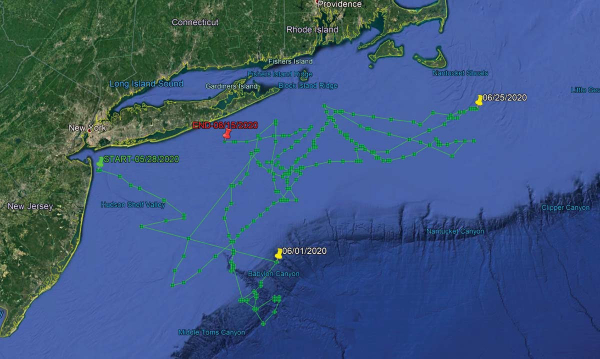 The first striper deployed with a MiniPSAT device in 2020, Rona shows a rather incredible migratory journey between May 28 and August 15. The first striper deployed with a MiniPSAT device in 2020, Rona shows a rather incredible migratory journey between May 28 and August 15.“They typically transmit for 10 days until the battery dies,” said Roxanne Willmer from Gray FishTag Research explaining how anywhere from 17,000 to 20,000 transmission attempts from the MiniPSAT devices to the overhead satellites once they’ve detached from the fish and floated to the surface. In 2019, both tagging devices were returned after being found on beaches along the Striper Coast, which is what researchers hope happens in 2020 as well. “If we do find them on a beach in three months then we can plug them in, which doesn’t require the battery, and get all of the data, maybe a more defined tracking,” Willmer said. Heading back to the nautical charts with Navionics App in hand, we set to plotting Rona’s course from date of deployment off the Jersey Shore until the tag began to transmit 85 days later. As difficult as it was for any one of us to process – and as hard as it might be for readers to believe – that big fish also traveled southeast along the Hudson Shelf Valley after being tagged, swimming approximately 100 nautical miles to the tip of the Hudson Canyon over the course of just 4 days. “Likelihood” is a common word used in science; based on the best available science, there’s always a probability or chance of something occurring or not occurring in nature, especially when inserting man into the equation. And from the data stored in that MiniPSAT device attached by fishermen into Rona at the beginning of the June, the tracking data showed the likelihood that she was finally on her way towards Moriches Inlet later that month after swimming around the edge of the Hudson and Toms. It would appear that Rona did swim back and forth across the line off Long Island at some point, but data fed to the Argos satellite shows a lot of ground covered over the span of a few weeks before making her northeastern-most stop along Nantucket Shoals by June 25, at roughly the same time as Cora. 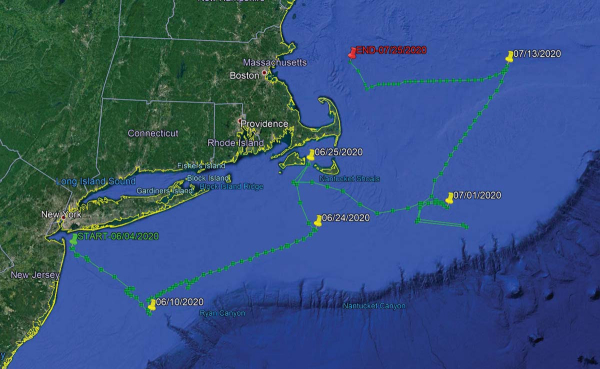 While Cora was the second fish “sat” tagged on June 3, hers was the first MiniPSAT to “ping” the Argos satellite on August 1 after coming undone prematurely on July 25.And similar to Cora which traversed darn close to the Texas Tower, data shows Rona making a quick run southwest of the Hudson tip in the area around the Triple Wrecks where yellowfin action was completely off the charts in 2020 with pelagics gorging on sand eels and keeping rods bent through early fall. While Cora was the second fish “sat” tagged on June 3, hers was the first MiniPSAT to “ping” the Argos satellite on August 1 after coming undone prematurely on July 25.And similar to Cora which traversed darn close to the Texas Tower, data shows Rona making a quick run southwest of the Hudson tip in the area around the Triple Wrecks where yellowfin action was completely off the charts in 2020 with pelagics gorging on sand eels and keeping rods bent through early fall. On the move again in a northerly direction, Rona then covers a lot of ground south of Shinnecock at offshore areas during the summer as well, not far from where the Coimbra and Ranger wreck sites were ripe with life in 2020, and at roughly the same time. “What is surprising is the magnitude of the apparent movements of these fish into offshore waters,” said John A. Tiedemann, Assistant Dean in the School of Science at Monmouth University and a longtime striped bass researcher and surfcaster. Tiedemann said he’s gone through 50 years of scientific research without finding any real evidence of such a long range offshore migration; he also noted how there’s never been a satellite tagging effort like this either.“In terms of their range offshore, the striped bass is typically characterized as a nearshore coastal fish and very few life history accounts provide evidence of movements onto the outer continental shelf region,” said Tiedemman, adding “Further analysis of environmental data associated with the movements of these fish may shed light on whether they are moving offshore in response to water temperature, food availability, or simple wanderlust.” Connect The DotsWhere Cora and perhaps a few of her compatriots continued east/northeast, Rona’s satellite tracking shows her cruising back towards Montauk, maintaining an offshore route and crisscrossing her earlier travels until the tag was released somewhere outside of Moriches. Whether she’s still swimming today or was brought to market is anyone’s guess. But as with all of the striped bass fit with MiniPSAT devices, there’s also a green streamer tag affixed to every fish to hopefully gather data on the final stats of each striper tagged. That’s all part of an even bigger effort to get more of the public involved on this collaborative work. 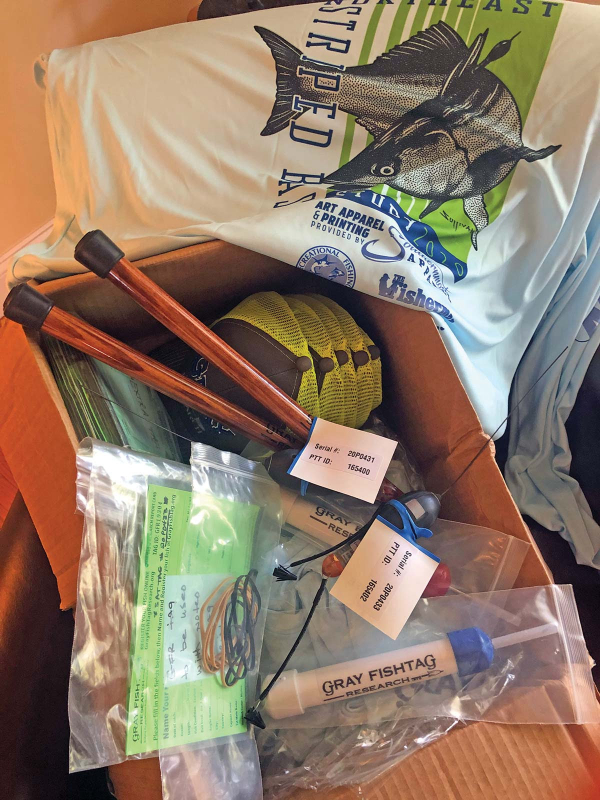 While a global pandemic impacted scheduling of the 2020 Northeast Striped Bass Study, the first batch of tagging gear arrived just in time for the Memorial Day weekend.“It is our team’s mission in our tagging work to always keep the data collected as open access to all,” Dobbelaer said of the team’s research, adding While a global pandemic impacted scheduling of the 2020 Northeast Striped Bass Study, the first batch of tagging gear arrived just in time for the Memorial Day weekend.“It is our team’s mission in our tagging work to always keep the data collected as open access to all,” Dobbelaer said of the team’s research, adding “We will only conclude on the tagged specimen that we are studying, assume nothing of other fish movements or patterns, and continue to look for ways to evolve our own model.”One of those ways is through the use of the green spaghetti tags that have been distributed this season to handful of local charter captains, and which hopefully can be integrated into even more widespread use by anglers in the future science of striped bass. Dobbelaer said that the Gray FishTag Research goal is to expand on their tagging model to gather data from thousands of tagged stripers from the Mid-Atlantic and Northeast, and hopefully using telemetry tagging with a robust spaghetti tag effort to not only track mortality and migration, but to better understand this offshore anomaly.“It is shocking in a short period of time the speed and distance in which these fish traveled. This information is so contrary to what we all have been told,” Dobbelaer said throwing in yet another $10,000 question. “So, what do we do with this astounding information and where do we go from here?”Tiedemman said that although individual striped bass exhibit variable rates of transit, it’s been well established they can move considerable distances in short periods of time. “For example, a fish we acoustically tagged on June 7, 2019 in Sandy Hook Bay was detected off Montauk less than a month later on July 3,” he said, adding “a study published in 2014 documented a striper moving from Delaware Bay to coastal waters off Massachusetts in just 9 days.” Although the number of fish tagged in Northeast Striped Bass Study is still small and thus far only conducted with spring deployments, Tiedemman said it appears to be providing new information on spring and summer movements of larger bass in the region, adding “As the number of satellite tags deployed increases the data yielded by this effort will become more complete and robust.” Again, are we seeing a pattern? Probably too soon to tell, which is why the Northeast Striped Bass Study will continue with support from the fishing community. And on July 3, our team deployed a third MiniPSAT device for 2020 in a 46-inch striper named Independence somewhere between the Porgy Hump and Pollock Rip off Montauk.Furthermore, our team is hoping to be back in action in October for yet another expedition somewhere off Gloucester, MA with Wicked Tuna skipper Dave Marciano in hopes of finding another jumbo to perhaps connect a few more of the striper dots. As of this writing, we again wait with baited breath. READ MORE LIKE THIS AT www.thefisherman.com. |
Category Archives: Saltwater Fishing
Alabama Anglers Get More Snapper Fishing Opportunities to Meet Quota
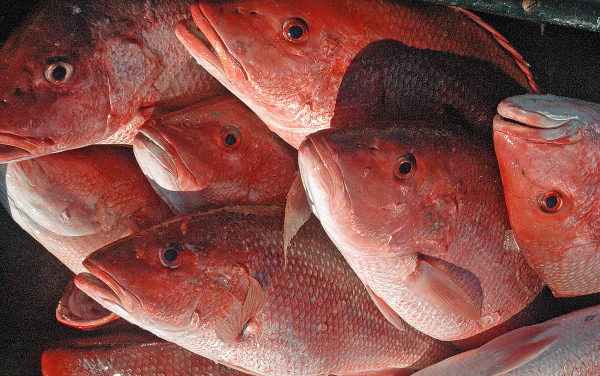
Anglers have yet to reach this year’s quota, and next year promises even greater opportunities thanks to new stock assessments indicating far more red snapper than previously believed.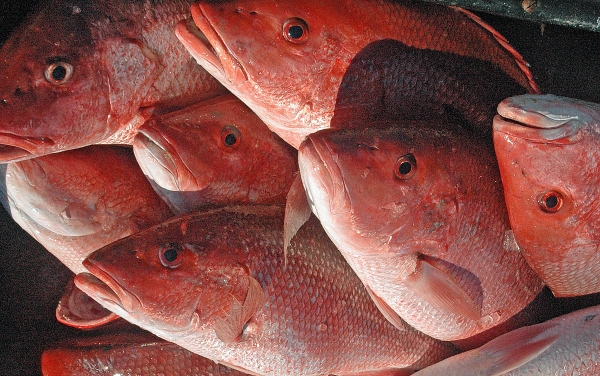 By DAVID RAINER By DAVID RAINERAlabama Department of Conservation and Natural Resources from The Fishing Wire If the recent blustery weather caused anglers to forgo a red snapper trip during the weekend extensions, don’t fret. Scott Bannon, Director of Alabama Marine Resources Division (MRD), assures that private recreational anglers will have the opportunity to harvest the remaining quota. The original plan was for a three-day extension from October 10-12, but Hurricane Delta foiled that plan. With snapper remaining in the quota, Alabama Conservation Commissioner Chris Blankenship and Bannon amended the extension to include Saturdays and Sundays until the quota is projected to be met. “Remember, we are fishing to the pounds available in the annual quota, not to the dates,” Bannon said. “We expected a relatively low turnout for that three-day weekend. The only day with decent weather was Monday. We decided to leave that weekend open if anybody had the opportunity to go. ”What MRD officials discovered through Snapper Check was that a few brave anglers decided to venture out in the rough seas. Bannon said there were Snapper Check reports on Sunday and Monday of the Hurricane Delta weekend. “That was not the weather I would have fished in,” Bannon said. “Although the weather was better Monday, some people in smaller boats went out and turned around. They didn’t feel safe or comfortable. I think that was a wise decision, but they will get opportunities later. “Looking at the public access boat ramps, there were a few trailers, but they were not full. I think there are some Hurricane Sally residual effects. People are still trying to clean up from the impacts, whether it’s their homes, docks or boats. Some marinas are not capable of putting boats in the water. Some of the dry storage facilities are damaged. Wet slips are not available. The two hurricanes are playing a factor in the reduced effort. I think it will be a while before the Gulf Coast is back up to full fishing force.”Bannon said the best way to manage the season was to leave it open on weekends until the quota is met. 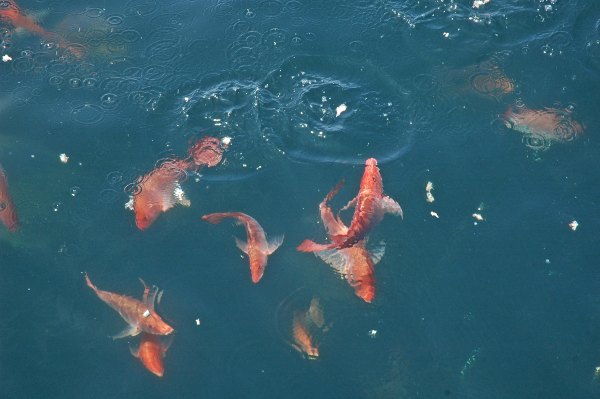 “This time of year, we will continue to have challenges with the weather,” he said. “People will have multiple conflicts with their schedules based on kids being in school and hunting seasons. We know the weekend effort won’t be like summertime weekends. We will keep up with the harvest through Snapper Check and post it on our webpage (www.outdooralabama.com/2020-red-snapper-landings-summary). “This time of year, we will continue to have challenges with the weather,” he said. “People will have multiple conflicts with their schedules based on kids being in school and hunting seasons. We know the weekend effort won’t be like summertime weekends. We will keep up with the harvest through Snapper Check and post it on our webpage (www.outdooralabama.com/2020-red-snapper-landings-summary).“We will try to give people as much notice as we can about when the quota is anticipated to be met. But I think it will take several weekends now.”As with any hurricane makes landfall along the Alabama coast, the storm can cause artificial reefs to be displaced, which was the case with Sally. “We are already aware that some lighter-weight material, like the chicken transport devices, were moved,” Bannon said. “Some of the state’s nearshore reefs have been moved. But they are relatively close to where they were deployed. The Dauphin Island Sea Lab (DISL) has identified some spots that have moved. We’re doing some surveys in our nearshore reef zones to determine the impact, and we’ll do some checks of offshore reefs later. “Pyramids and larger items that have been there for a while and are planted in the bottom, they’re not going to move. Some items have turned over, but that’s fine. They still provide structure. We don’t think it will negatively impact the fish. I’ve also seen some social media posts where people have been looking for spots and located them nearby.”More good news for red snapper anglers came recently when preliminary results from the Great Red Snapper Count were presented to the U.S. Congress. Alabama Senator Richard Shelby was among the legislators who pushed a $10 million appropriation through Congress to fund the research.“I have not seen the full report, but the estimate from the Great Red Snapper Count is that the snapper population is about three times larger than what was previously thought,” Bannon said. “One of the interesting portions of the report is the number of red snapper that are not on natural or artificial reefs. The number of snapper that are out on the flat areas, so to speak, are much higher than previously thought. Those fish are not accessed by anglers, so those fish will continue to be there based on the current fishing methods.”Bannon said the Great Red Snapper Count information will be used by NOAA (National Oceanic and Atmospheric Administration) to create an interim stock assessment for red snapper. The Harte Research Institute for Gulf of Mexico Studies at Texas A&M University was the lead for the Great Red Snapper Count. The work off the coast of Alabama was led by Dr. Sean Powers of the University of South Alabama. “We’re anticipating hearing about the interim assessment in the near future, and that will impact the 2021 season for all sectors – commercial, for-hire and private anglers,” he said. “But this will not mean a three-time increase in the quota. The data from the red snapper count isn’t the only factor that goes into an interim analysis. It’s an important factor but only one source of data that goes into the analysis. “However, this is excellent news. It is something we had anticipated. We expected the method used would reveal there were more snapper in the Gulf. It was a very important study, and Senator Shelby’s office was instrumental in providing funding for that.”Bannon said the results of the Great Red Snapper Count may relate to a number of other fish species in the Gulf as well. “What we learned from this is whether we need to change some of the analysis methods for all species – the way we conduct stock assessments,” he said. “Do we need to continue to adjust our assessments closer to this model to ensure we’re getting accurate stock assessments.” Bannon said the research that MRD and The University of South Alabama conducts in Alabama’s unparalleled artificial reef zones, which cover more than 1,000 square miles in the Gulf, was the genesis of the methods used in the Great Red Snapper Count. “Because of the research done in our reef zones, we have said for the last eight years hat we had a very good understanding of the abundance of fish off of Alabama,” he said. “Now that we have that information from across the Gulf, it is good to know that the snapper stock is in better condition than some people anticipated. It’s a very positive outcome for red snapper anglers.” Bannon said private recreational anglers can pick the days best for them to take advantage of the red snapper weekend extensions.“We’re fishing to the quota,” he said. “If it’s not comfortable or safe to go, don’t go. The fish are still in the bank, so to speak. We will keep Saturdays and Sundays open until we anticipate the quota being met, and that could be as soon as the end of this next weekend.” |
How To Catch November Reds, Trout and Flounder in Mobile
November Mobile Reds, Trout and Flounder
with Captain Dan Kolenich
“November is one of the two best months of the year for catching reds, trout and flounder in Mobile,” Captain Dan Kolenich said. As the water cools and freshwater starts flushing out the bay, shrimp move toward the ocean and you can catch all three species. The shrimp are mature and as big as they get, so they are even more attractive food in November. Only in May, with the shrimp are moving in and the fish are following them, is as good.
Captain Dan moved to the Mobile area in 1979 and fell in love with the fishing, learning how to catch reds, trout and flounder in the bay as well as all the species available in the area. He started guiding 18 years ago, and has also fished some of the professional redfish tournament series like the Inshore Fishing Association (IFA) Redfish Tour and the Oberto Redfish Cup. They do not fish Alabama waters so raveling to different areas like Florida and Louisiana in those tournaments helped him learn to find even more fish in Mobile.
Until a few years ago most of his guide trips were with clients that wanted to catch fish on spinning tackle, with one or two fly fishing trips per year. But now 60 to 70 percent of his trips are fly fishing trips and he is able to help fly fishermen catch trout and reds, with the occasional flounder, in the bay and rivers.
Although he sometimes uses live bait like pogies, bull minnows and shrimp, he prefers artificals. His favorites for spinning tackle are High Tide plastic shrimp and minnows on their B52 jigs and he sometimes makes them into spinnerbaits by adding a Hildebrant blade on a wire. Those baits are soft and flexible but hold up well, allowing you to catch many fish on one bait before you have to change.
He also casts a Mirror Lure 32 M lure as well as their Top Dog Jr. topwater plug. As the shrimp become scarce the fish feed more on baitfish that these plugs, as well as the soft minnow lures, imitate.
“When you start catching freshwater drum where you had been catching trout and reds a few days earlier, its time to move further out,” Captain Dan said. Starting somewhere around Thanksgiving and lasting until Christmas, the water cools and fresh water flushes saltwater out of the bay and fishing becomes difficult for desired species. But until that happens, fishing is excellent, and you can follow the bait and fish as they move further out.
Early this month start fishing about five miles upstream of the causeways and by the end of the month you should be fishing within a mile of the causeways. Start up the Tensaw and Raft Rivers around Gravine Island and work down those rivers as the fish move out. The Blakeley River is another good place to try. Later in the month concentrate on the Spanish and Apalachee Rivers.
The pilings on the causeways that cross the bay are also good, with some fish around them all month, but they get better later as fish in the rivers move down and join resident “piling” fish.
Early in the month you can catch trout around shallow wood cover up the rivers and reds over grass beds on high tide. An east wind will often push an additional foot of water into the bay, making the shallow bite better. For shallow water, plugs work well since you can keep them over the cover. Birds feeding back in bays and sloughs are a good sign the fish have pushed bait into those places and are active in them.
For trout, find logs and trash on the bottom in two to three feet of water and work the Top Dog Jr over them. Their C-Eye Suspending Twitch Bait will suspend 12 to 18 inches deep, allowing you to work it over the cover. Trout seek water in the 70 to 80-degree range, so look for those temperatures for the best fishing.
For reds, work those same baits over the grass beds in shallow water three to five feet deep. Sometimes you can see reds feeding in the shallow water or the mud stirred up by them. They are in these areas feeding on crabs and minnows. Cast far enough ahead of feeding fish that you don’t spook them and start working it when they get close to it.
As the tide moves out it pulls water, bait and fish out to deeper water near the channels. In the rivers the bottom slopes off in a shelf out to one to 10 feet deep then flattens out to about 12 to 14 deep before falling into the channels. Captain Dan says about one-third of the river will be this creek bottom at the 12 to 14 feet deep and that is the depth trout and reds hold and feed.
That is a lot of water to cover but Captain Dan says it is easy to find the fish since lines of boats will be drift fishing around them, and you can join them. Go up current to the head of the line, put out your lines and drift through the fish. When you stop getting bites reel in, crank up and go back to the head of the line to start another drift.
This is the accepted method of fishing in the crowd. Captain Dan warns that you should not anchor when you catch a fish, it lessens your chance of catching more fish and, worse, it messes up everyone else fishing the correct way, drifting through them. The only anchored boats are going to be fishermen that really don’t know how to catch the fish.
Until Thanksgiving a good day trout fishing will produce 30 to 40 keeper size fish. After Thanksgiving you may catch only four or five, but they will all be gator trout, over 20 inches long.
For both trout and reds a High Tide shrimp or minnow behind a jig head work well. Both will hit them when drifted near the bottom. Vary the weight of your jig head depending on your drift speed, starting with a three sixteenths head, to keep your bait near the bottom. A red head High Tide jig head is Captain Dan’s go-to color. You can use live bait, but Captain Dan prefers artificials for ease of fishing as well as reducing costs.
Reds like a bait right on the bottom and this is when Captain Dan likes to put a spinner over his jig. It gives you more depth control as well as attracting fish to the bait. Try to keep it within a foot of the bottom.
Flounder also feed in the rivers this time of year and will hit jigs, but they tend to hold on points where rivers and creeks come together. They sit on the bottom and feed, not really moving around much. You can catch them by drifting and casting to the points along your drift, but a good tactic for flounder is to anchor next to a point and cast up current on it.
Use a jig and let it sink and work it with the current just over the bottom. When a flounder hits there is no doubt, according to Captain Dan. When they take a jig it is a hard hit and they tend to hook themselves.
Bull minnows are also good for flounder and you can catch them “Carolina Rig” style, with the hook on a two-foot leader behind a sinker. Cast or drift this rig on points and drag the sinker along the bottom, adjusting the weight of it with the current so it stays on the bottom.
Don’t “set the hook” hard on a trout, just tighten up and raise your rod tip. A hard hook set can tear the hook out of their mouth. A red will hit hard and run and set the hook itself but you do not want to jerk your rod tip since their rubbery mouth can tear.
For all three species Captain Dan uses a seven-foot medium action Falcon rod with a Okuma spinning reel. The rod’s light tip helps keep from tearing the hook out of the soft mouth of trout but is strong enough to hook the rubbery mouth of a red, and it has enough backbone to fight them efficiently.
The reel has an extremely smooth drag, important when fighting a red on the ten-pound test line he uses. He does tie a 12 to 18-inch 17-pound fluorocarbon leader on his main line, which is either Power Pro braid or monofilament. The leader helps since there are a lot of things to abrade your line.
Although red’s mouths are tougher than trout’s, they are soft and the rod action and light line, as well as a smooth drag, are all very important to keep from losing hooked fish.
Captain Dan an Orvis endorsed fishing guide. He uses nine-foot, eight weigh rod and says you need a fast sinking “depth charge” line to get down to the fish. He drifts with a Clouser minnow fly and it needs to be fished at the 12 to 14-foot depth where the trout and reds are feeding. You can cast the same bait for flounder but it, too, must be near the bottom for them.
The pilings on the bridges are good places to cast a fly or jig for all three species. Contrary to what seems to be intuitive, Captain Dan has found fish hold on the up current side of the pilings rather than in the eddy on the downstream side. There may be some fish on the eddy side, but, much like dolphins riding the bow wave of a ship, fish hold in the upstream ‘dead zone” break better.
Hold your boat on the up current side of the piling and cast your Clouser minnow or jig up to the front of the piling rather than past it, and let your bait sink down in the dead zone there. Try letting the bait sink to different depths to see if the fish prefer a certain depth. Live shrimp or minnows can be fished on the pilings in the same way.
Captain Dan encourages catch and release on all fish but he does not mind if you keep just enough for a fresh meal. Releasing all or most of your catch helps insure the fishing will be good in the future. The size restrictions on reds and trout has really helped the fishing, too.
There is a ten fish, 12-inch minimum size limit on flounder. Trout also have a ten-fish creel limit and must be over 14 inches long. There is a three-fish limit on reds and you can keep fish between 16 and 26 inches long, but only one over the 26-inch length. Reds over 26 inches long are the brood stock and all should be released, and Captain Dan says they are really not very good to eat at that size, anyway.
More than the usual amount of rain in the fall can flush out the saltwater earlier and muddy up the rivers, make fishing more difficult. Strong winds can also create problems. It helps to have an experienced guide to adapt to daily changes in conditions.
When you find the kinds of places these fish feed, don’t get stuck fishing familiar places. Captain Dan says finding new, similar places is one of the thrills of fishing here, and there are a lot of them to explore.
All you need on a guided trip with Captain Dan is what you want to eat and drink to put in his ice chest, hat, sunglasses, sunscreen, camera, and clothing like a long sleeve shirt and rain gear. He asks you to wear soft sole shoes. Although he provides all tackle he says you are welcome to bring your favorite rods, reels and tackle to use. You do not need a saltwater license when fishing with him but if you go into freshwater you do need a freshwater license.
Contact Captain Dan for a guided trip fly fishing or spinning tackle fishing, at 251-422-3474 or email him at info@captaindankolenich.com. His website at captaindankolenich.com has fishing reports as well as more information on his trips.
Massive Goliath Grouper Bites–On Camera
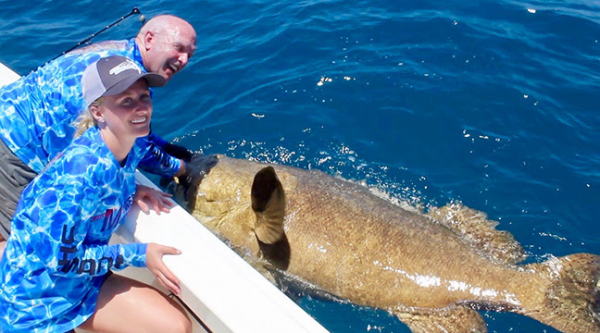
| from The Fishing Wire Crosslake, MN – A 29-hour drive to escape the Minneapolis riots had landed fishing guide Paul Hartman and his family in Marco Island, Florida. On May 31, Hartman, his wife Kimberly and stepchildren Reegan and Owen Werner would be 50 miles out in the Gulf of Mexico, wrestling a record-class goliath grouper. Before the battle ensued, they’d watch the mammoth fish bite on the screen of their Aqua-Vu underwater camera. Early in the day, on the way to their offshore fishing spot, Hartman and family had tried to catch a few amberjack for grouper and shark bait. Each time they hooked one, however, a barracuda attacked and stole their prospective bait. After boating two of the big ‘cuda, Hartman finally decided to cut the tails off the toothy fish, and rig each on a 12/0 circle hook in hopes of tempting a hungry shark or goliath grouper. Attached to heavy-duty rods and Penn International reels loaded with 250-pound braided line, the baits plummeted into 50 to 70 feet of water.Hartman and his family watched the grouper eat the bait on the screen of their Aqua-Vu HD10i Pro underwater camera. Endeavoring to witness and record the actual bite, Hartman and his son attached one of the fishing lines to the “Live Strike” release clip connected to the lens of an Aqua-Vu HD10i Pro camera. “We had rigged the camera to face at about a 45-degree downward angle, keeping the lens just a few feet above the bait,” said Hartman, a well-known fishing guide specializing in trophy muskellunge back in Minnesota. “We watched on screen as the big chunk of ‘cuda sank down toward bottom. Almost right away, my son Owen excitedly described the action as he watched a massive grouper charge over and eat the nearly 50-inch bait in one big gulp.” “When Owen saw the fish coming, he screamed, ‘It just ate the whole thing! The whole entire bait is gone!” recalled Hartman. “I reeled down, got the fish hooked and the fun began.” Unfortunately, in the heat of the moment, the family forgot to hit the record button and failed to capture the underwater video with an attached recording device. “But watching that giant grouper engulf the entire bait in one powerful snap has given us ample incentive to try again. What an experience! ”Equipped with 125-feet of heavy-duty cable, the Aqua-Vu HD10i Pro high-definition underwater camera houses internal weights and allows the user to attach additional 1-pound weights as well as the XD Live Strike™ accessory, via Aqua-Vu’s Quick Attachment system. In effect, the camera acts as a weight, pulling the bait toward bottom. The Aqua-Vu XD Live Strike accessory lets anglers watch fish react to lures and baits in real time. The Live Strike accessory slides easily onto the camera lens housing, terminating with a downrigger-style line clip. Anglers can instantly attach their fishing line to the release clip and monitor the lure or bait on the LCD display above. When a fish strikes, the line is effortlessly pulled off the clip for a direct rod-to-fish battle. The Aqua-Vu XD Live Strike system is the only fishing-ready video device that allows for full HD viewing of lures and striking fish in real time. “Having just witnessed the sheer size of the animal as it swam over and engulfed the bait, Owen was buzzing with excitement,” recalled Hartman,” “That got us fired up, too. I asked Kimberly to back the boat away from the structure, while I gently towed the unsuspecting fish to smoother bottom, where it would be more difficult to wrap the line around an obstruction and break off. As Reegan strapped on the fighting belt, I handed her the rod and told her to get ready for a battle.“Once the fish realized it was hooked, it began thrashing and surging. Reegan is an athlete with lots of competitive spirit, but at 115-pounds, she was in for a major challenge versus a fish five times her weight. After just ten minutes, with assistance from her brother Owen, Reegan managed to get the fish up off bottom and into view, so we could get a good idea of its enormous size. After working the fish hard for another 5 minutes, I was able to grab the 400-pound test cable leader and begin measuring the fish boatside. We got the hook out, took a few photos, and let the fish give us shower as it kicked and swam back to the depths.” Later, looking at the photos, Hartman realized the goliath grouper was almost certainly the same fish caught by a friend in April of 2019, a specimen named My Lord. Just 14 months later, the fish had grown three inches and gained 50 pounds, now measuring 83-inches long with a 75-inch girth and estimated weight of 583-pounds. According to the International Game Fish Association, Reegan Werner’s fish was the largest grouper ever caught by a female angler. “The first time my friend Captain Ben Olsen saw the fish, all he or his crew could say was ‘oh my Lord, look at that!’” said Hartman. “Eventually, the name stuck and when we got back in and looked at our photos, we realized, the fish was indeed the same one.” Hartman notes that responding to declining goliath grouper populations, the Florida Fish and Wildlife Conservation Commission prohibited all harvest of the magnificent sportfish from U.S. waters in 1990. Since then, goliath grouper populations have rebounded in certain areas around Florida’s Gulf Coast. “It’s not like these fish are super abundant,” Hartman added. “You can find five to ten fish living on one particular structure. But then you might not find another big grouper for 30 to 50 miles. Releasing these fish safely and carefully is a must. Who knows, next year, we might come back and watch My Lord eat on the camera again. Who knows how much bigger she’ll be. This time, you can be sure, we’ll hit the record button.”About Aqua-VuThe Original Underwater Viewing System, Aqua-Vu® is manufactured by Outdoors Insight, Inc., and has led the underwater camera category in design, innovation and quality since 1997. The Central Minnesota based company builds other popular outdoors products, such as the iBall Trailer Hitch Camera (iballhitchcam.com). For more information on Aqua-Vu, visit www.aquavu.com. |
Measuring Atlantic Bluefin Tuna With a Drone
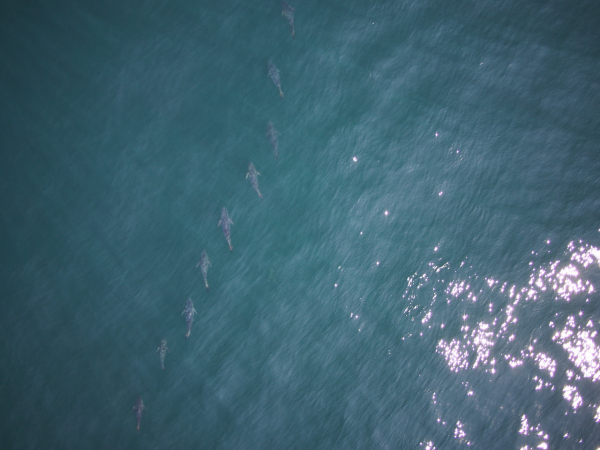
| Measuring Bluefin Tuna This novel use of drones is a promising way to remotely monitor these hard-to-see fish. From NOAA Fisheries from The Fishing Wire Researchers have used an unmanned aerial system (or drone) to gather data on schooling juvenile Atlantic bluefin tuna in the Gulf of Maine. This pilot study tested whether a drone could keep up with the tuna while also taking photographs that captured physical details of this fast-moving fish. The drone was equipped with a high-resolution digital still image camera. Results show that drones can capture images of both individual fish and schools. They may be a useful tool for remotely monitoring behavior and body conditions of the elusive fish. Individual fish lengths and widths, and the distance between fish near the sea surface, were measured to less than a centimeter of precision. We used an APH-22, a battery-powered, six-rotor drone. The pilot study was conducted in the Atlantic bluefin tuna’s foraging grounds northeast of Cape Cod in the southern Gulf of Maine.Mike Jech about to launch the APH-22 from the bow of the F/V Lily. Photo @2015 Eric Schwartz.“Multi-rotor unmanned aerial systems won’t replace shipboard surveys or the reliance on manned aircraft to cover a large area,” said Mike Jech, an acoustics researcher at the Northeast Fisheries Science Center in Woods Hole, Massachusetts and lead author of the study. “They have a limited flight range due to battery power and can only collect data in bursts. Despite some limitations, they will be invaluable for collecting remote high-resolution images that can provide data at the accuracy and precision needed by managers for growth and ecosystem models of Atlantic bluefin tuna.”Results from the APH-22 study were published in March 2020 in theJournal of Unmanned Vehicle Systems. Researchers conducted their work in 2015. They then compared their study results to values in published data collected in the same general area. They also compared it to recreational landings data collected through NOAA Fisheries’ Marine Recreational Information Program. Taking up the Bluefin Tuna Sampling ChallengeAtlantic bluefin tuna is a commercially and ecologically important fish. The population size in the western Atlantic Ocean is unknown. Fishery managers need biological data about this population, but it is hard to get. Highly migratory species like Atlantic bluefin tuna often move faster than the vessels trying to sample them. The tuna are distributed across large areas, and can be found from the sea surface to hundreds of feet deep. Sampling with traditional gear — nets and trawls — is ineffective. Acoustical methods are useful but limited to sampling directly below a seagoing vessel with echosounders or within range of horizontal sonar. It is also difficult to estimate the number of tuna in a school from an airplane. Both fish availability and perception biases introduced by observers can affect results. Estimates of abundance and size of individuals within a school are hard to independently verify. Taking precision measurements of animals that are in constant motion near the surface proved easier with a drone that is lightweight, portable, and agile in flight. It can carry a high-quality digital still camera, and be deployed quickly from a small fishing boat. Short flight times limit a drone’s ability to survey large areas. However, they can provide two-dimensional images of the shape of a fish school and data to count specific individuals just below the ocean surface.New Capacity for Bluefin Tuna Monitoring The APH-22 system has been tested and evaluated for measuring other marine animals. It’s been used in a number of environments — from Antarctica to the Pacific Ocean — prior to its use in the northwest Atlantic Ocean. Previous studies estimated the abundance and size of penguins and leopard seals, and the size and identity of individual killer whales. Hexacopter image of a school of Atlantic bluefin tuna taken northeast of Provincetown, Massachusetts in the southern Gulf of Maine. “The platform is ideal for accurately measuring fish length, width, and the distance between individuals in a school when you apply calibration settings and performance measures,” Jech said. “We were able to locate the hexacopter in three-dimensional space and monitor its orientation to obtain images with a resolution that allowed us to make measurements of individual fish.” As new unmanned aerial systems are developed, their use to remotely survey Atlantic bluefin tuna and other animals at the sea surface will evolve. It may minimize the reliance on manned aircraft or supplement shipboard surveys. The International Commission for the Conservation of Atlantic Tunas governs tuna fishing. It is entrusted to monitor and manage tuna and tuna-like species in the Atlantic Ocean and adjacent seas. NOAA Fisheries manages the Atlantic bluefin tuna fishery in the United States. We set regulations for the U.S. fishery based on conservation and management recommendations from the international commission. For more information, contact Shelley Dawicki |
California Catch of Swordfish Takes Off as Anglers Embrace New Technique
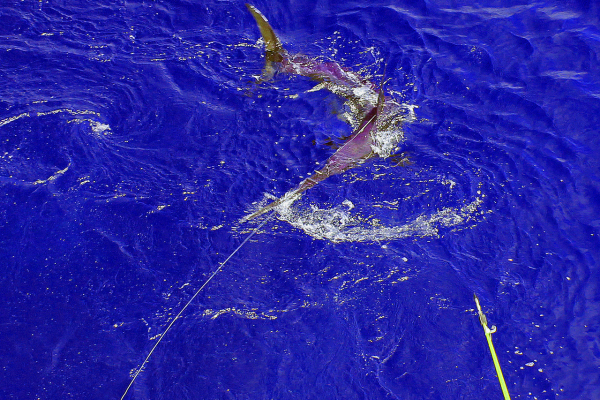
| From NOAA Fisheries from The Fishing Wire Researchers have tagged swordfish off Southern California for studies evaluating new ways of fishing for the species. Credit: Pfleger Institute of Environmental Research (PIER)Recreational fishing for swordfish off southern California has surged over the last year. Fishermen have started borrowing a strategy from East Coast anglers and the commercial fishing world: going deep during the daytime. Tagging and tracking research by NOAA Fisheries and the Pfleger Institute of Environmental Research (PIER)revealed that swordfish spend most of the day at depths greater than 700 feet. Commercial fishermen on the West Coast originally began fishing in deeper waters for swordfish. They used buoy gear in part to avoid protected species such as sea turtles and marine mammals. Now recreational anglers on the West Coast have caught on to the technique and have seen their catches increase dramatically. Chugey Sepulveda, PIER Director and Senior Scientist, said anecdotal numbers suggest that recreational swordfish catches off southern California have jumped. They’ve gone from fewer than 30 in a typical year to hundreds in a matter of a few months. “It’s been a real boost for the recreational fleet because it now offers anglers a new and exciting quarry that was previously considered extremely difficult to target,” he said. Research shows that swordfish spend most daytime hours at depths of 700 to 1,400 feet, coming only occasionally to the surface. Recreational fishermen had once primarily pursued them only when swordfish were spotted basking on the surface. Days of excitedly dragging a bait in front of a sunning swordfish have turned into long days of staring at rod tips. “Swordfish have always been considered the pinnacle of fishing success since the days of Zane Grey,” said Bill DePriest, publisher and editor of Pacific Coast Sportfishing Magazine. “Now it’s something more people are experiencing.” Catch and Release Ethic Emerges As catches have increased, many fishermen are now discussing bag limits and potential catch-and-release measures to prevent exploiting the swordfish stock, Sepulveda said. Swordfish populations in the North Pacific include two stocks: an eastern Pacific Ocean stock and a Western and Central North Pacific Ocean stock. There continues to be discussion as to which stock southern California fish belong. This is one reason why Sepulveda and his team have headed up NOAA Fisheries-sponsored research on stock structure. The 2018 stock assessment for the Western and Central North Pacific Ocean swordfish stock found off the West Coast shows that the stock is not overfished. It is also not experiencing overfishing. The assessment also found that the stock can support more fishing while remaining sustainable. It found that the biomass shows “a relatively stable population, with a slight decline until the mid-1990s followed by a slight increase since 2000.”Figure. Recreational fishermen have employed similar methods on the U.S. East Coast and other areas. Recreational anglers on the West Coast have caught on to the strategies and techniques more recently as the new deep set commercial fishery has taken off. The main season for swordfish off southern California is roughly from late summer into winter, DePriest said.“It’s a healthy hobby. And with swordfish, it’s definitely always exciting,” DePriest said. “It’s great to see so many people interested.” Pacific swordfish are highly migratory and often travel thousands of miles across international boundaries. Since many nations target the species, effective conservation and management requires international cooperation as well as domestic attention. Scientists are now seeking funding for a study to collect more data on the growing recreational fishery. Data is needed to evaluate the survival of swordfish that are caught and then released. While there are best practices for choosing the right gear and handling with care when catch-and-release fishing, survival rates vary by species. Recreational anglers can also contribute to swordfish research by participating in our Southwest Fisheries Science Center’s Cooperative Billfish Tagging Program. The program, started in 1963, provides tagging supplies to anglers. It helps us better understand movement and migration patterns, species distribution, and age and growth. Anglers tag the fish before releasing them. |
Manta Ray Conservation and Best Cobia Fishing Practices
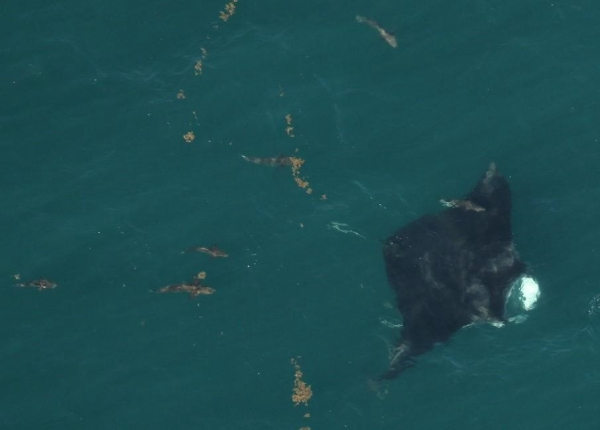
| Manta Rays and Cobia from The Fishing Wire Cobia frequently follow giant manta rays in their migrations, and fishermen targeting the cobia sometimes accidentally hook the rays. Here’s a Q&A from NOAA Fisheries with two well-known Florida skippers on the process and on protecting the relatively rare rays. As cobia season gets underway in the Southeast U.S., NOAA Fisheries reached out to one of our best resources: our fishermen. We wanted to find out what they do or recommend to fish for cobia while protecting threatened giant manta rays. Understanding the challenges fishermen face helps NOAA biologists and fishery managers find a way to protect threatened and endangered species and still offer fishing opportunities. Captain Butch Constable and Captain Ira Laks both helped us answer the following questions. Capt. Constable has been fishing offshore in Jupiter, Florida for more than 45 years. Capt. Laks has been a charter captain and commercial fisherman out of Palm Beach, Jupiter, and the Treasure Coast for more than 30 years. Both fishermen observe individual giant manta rays along the beaches of southeast FloridaWe appreciate the input these captains provided when we asked questions about cobia fishing. What time of year do you typically see manta rays arrive along Florida’s east coast? Capt. Constable: The manta rays used to show up in March, sometimes as early as February in cold weather years, and stay through May. Manta rays would move up the coast as water warmed. However, now there are no manta rays any more off of Jupiter in the early springtime. Warmer water temps have caused a shift in species and now the giant manta rays seem to stay further north. These days no mantas seem to be found in the spring south of Hobe Sound. I discovered another large ray, the Roughtail stingray, often has cobia swimming alongside so I look for them when sight casting. Capt. Laks: Most of the sight casting for cobia from Jupiter south is done around big sharks. The challenge with that kind of fishing is keeping a hooked cobia away from the shark so that it does not get eaten. What are some of the best fishing techniques you use when fishing for cobia around manta rays? Capt. Constable: The best advice is to practice and really have good casting skills from behind and to the side of manta ray. Do not cast in front of the manta ray. That way you can make a bad cast or two and reel in and recast without spooking the fish or hooking the ray. Capt. Laks: I like to come up slowly and from behind on either side of the manta and keep as much distance as possible to make a good cast. My best approach is with the winds behind me and the angler. That allows for a longer cast and it’s less likely to spook the manta with the boat. It also allows for several attempts in order to make that perfect cast to catch the cobia and not hook the ray. Are there any specific tackle or lures you would recommend to reduce foul hooking manta rays but still are effective at catching cobia? Capt. Constable: Single hooks! No reason to fish any sort of treble hook. Safer for angler when unhooking, safer for reducing snagging the ray. It would be good if a single hook series of baits and lures came out promoting cobia fishing in a responsible way. Also, anglers should use an oversize landing net and not a gaff for most cobia. Safer for fishermen and for cobia if kept or released. Capt. Laks: I specialize in live bait fishing and use only single hooks. Treble hooks are not necessary when live bait fishing for cobia. A single hook reduces the chance of snagging a manta ray if a bad cast is made in front of the ray. If a manta ray becomes foul hooked or snagged, what can fishermen do to reduce injury and trailing line? Capt. Constable: I recommend moving the boat in front of the ray, reeling up the line and trying to pull the lure gently from that direction. The hook will often pull out of the fish and not leave the lure or trailing line. If not cut the line as close to the ray as possible. Capt. Laks: I like to position the boat and move carefully as close as possible to the manta. Then I cut the line so as to leave the minimum amount of trailing line as possible. Have you ever seen a hooked manta ray or a manta ray showing evidence of vessel interactions (e.g., prop scars or cuts)? Capt. Constable: I have seen a few lures and jigs in rays but cannot recall prop scars or major injuries. Capt. Laks: I have seen a few with larger scars but not sure the cause of those injuries. What are some best practices for safe maneuvering your vessel around manta rays? Capt. Constable: I believe approaching slowly and carefully from behind so that it allows the captain to position the boat in a safe way and not spook the ray or the fish. This gives anglers the time to set up their cast and when the fish is hooked, it will usually swim away from the ray at first. Cobia will sometimes try to return to the ray but if the boat is behind, you can often hold the fish away from the ray and land the fish safely and determine its size. Capt. Laks: Do not set up in front of the ray. I recommend staying a distance away to allow the manta to stay calm and act normally. I can then set up to fish for cobia from behind and to the side of the animal. Capt. Laks: I also wanted to remind anglers that just seeing one of these large and amazing creatures is a thrill all by itself. It is a fortunate part of an amazing day of fishing and the overall fishing experience. |
Removing Billfish from the Water: Don’t Do It!
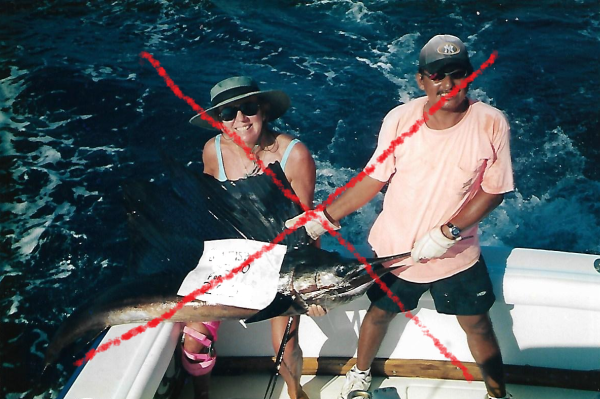
| Don’t Remove Billfish from the Water Anglers love hero shots with their fish, especially if it’s their first one. Of all the billfish species, sailfish lend themselves particularly well to this type of photo, since they’re usually small enough to lift up, have particularly gorgeous colors and that massive sail to hold out like a giant flag. But don’t do it! Removing any billfish species from the water, even for a few moments for a photo, is illegal, both in Costa Rica and the United States. Studies have shown that by scraping the fish over the gunwale of the boat, we are actually harming internal organs and removing the fish’s protective slime layer that acts as a barrier coat against harmful diseases, parasites and infections. Even though you intend to release the fish, by removing it from the water you may have just signed its death warrant instead. Here are a few things you can do to still get a great photo of your catch. First, be ready with the camera. Few things are more frustrating for your captain or mate than having the fish ready at boatside while someone fumbles for a camera deep inside a duffle bag or backpack. Be ready! Take a few shots during the fight, with the angler grinning from ear to ear. Once the fish is ready for release and the leader has been cut, the angler can don a pair of gloves, lean over the side and hold the fish by the bill and the sail as it’s revived alongside the boat. The cameraperson should lean out over the side and shoot back toward the angler and the fish. After a few moments, the fish is ready for a healthy release. Another option: the extended selfie stick and GoPro. Many crews are now using this setup to shoot wide-angle shots back at the boat and anglers. It’s simply a GoPro set on camera mode to shoot every second or so after the shutter is activated. It’s mounted to a long pole that’s held out away from the boat, and the images it reveals are usually very memorable. Video is a third way to remember the fight. Using that same GoPro, mount it to either a fixed mount on the boat or just hold it in your hand to capture a full video of the fight and the release. All smartphones have a video capability these days as well.So really, the need to remove a marlin or sailfish from the water just isn’t there. Be smart, keep them in the water where they belong. Courtesy The Presidential Flamingo Fishing Rodeo, Joan Vernon: www.preschallenge.com |
Tactics for Tempting Speckled Trout
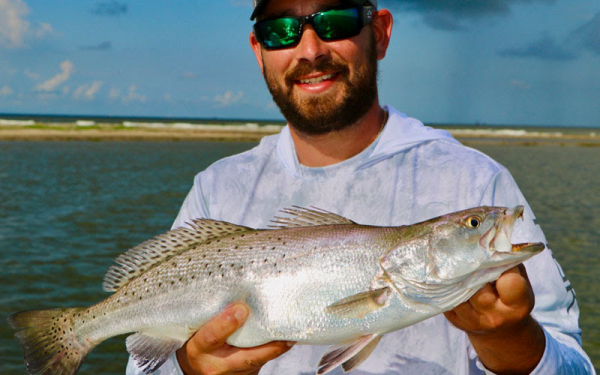
| Timely Tactics for Tempting Speckled Trout from The Fishing Wire “I can see the grill marks on that one already,” exclaimed Capt. Ryan Lambert as a beautiful Gulf of Mexico speckled trout was wrangled into the net and deposited in his boat’s ice chest. Lambert, the owner of Cajun Fishing Adventures in Buras Louisiana, has been guiding clients to spectacular speckled trout, boisterous bull reds, and more for over 41 years. Collectively, Lambert and his guides spend tens of thousands of hours on the water every year, and one lesson they have gleaned from these fertile marshes and bayous is not about baits or locations, but instead, about their lines and leaders. “Many of the largest trout we see every year come from water that is surprisingly clear,” notes Lambert, “and those fish can be pretty skittish. The key to getting more of those fish in the box is to rig up with a clear fluorocarbon leader.” Lambert and his guides like Seaguar Gold Label for its low visibility, knot strength and its toughness.One of Lambert’s guides, Capt. Joe DiMarco, puts it this way: “in the fall, trout move off the shallow flats and into cuts and channels where the water is deeper. There, they sit close to the bottom, in water that is warmer, saltier, and cleaner. The water might not look great from above, but often, just below the surface, chocolate milk-colored water can rapidly change to a perfect ‘trout green’. That’s where a Seaguar Gold Label leader can make the difference between a few small fish and some spectacular photo-ops.” Gold Label from Seaguar is a 100% fluorocarbon leader manufactured using a proprietary coextrusion process that unites a strong, sensitive core with a soft, supple exterior. The result is a double-structure fluorocarbon leader that exhibits the beneficial attributes of each of its two resins. With line diameters that are as much as 23% smaller than comparable fluorocarbons, Seaguar Gold Label is the thinnest 100% fluorocarbon leader available and is perfect for stealthy trout presentations. “Thinner leaders are always better,” asserts Capt. Mark Davis, host of BigWater Adventures TV. “When I fish with Gold Label, baits swim more naturally, triggering more bites and helping me to catch more fish.” Yes, thinner is better. But that’s not the end of the Gold Label story; rather, it’s just the beginning. Seaguar Gold Label excels at any presentation for line-shy fish, like fall speckled trout, because it is nearly invisible underwater. With a refractive index that more closely matches that of water than any other line choice, Seaguar 100% fluorocarbon leaders virtually disappear beneath the surface, ensuring that fish see your bait long before they ever detect your line. In addition, because Seaguar fluorocarbon leaders offer enhanced abrasion resistance compared to monofilament or braid, you’ll experience fewer line failures from sharp speckled trout teeth, or from the shell beds they frequently hold near. Moreover, the supple outer shell of Seaguar Gold Label ensures that knots snug down tight and strong, whether you’re connecting Gold Label to Seaguar Smackdown braided main line, or tying a jig to the business end of your leader. The exceptional tensile and knot strength that you’ll experience with Gold Label means fewer heartbreaks after the strike. Lambert says he targets speckled trout with one of two presentations – either tight-lining with a jig, or with a bait suspended beneath a popping cork.”I prefer tight-lining because the sensitivity of Gold Label, when paired with Seaguar Smackdown braid, lets me feel everything that is happening to the jig,” says Lambert. Gear up with a 7-foot, medium-heavy power, fast action rod equipped with a 3000-series spinning reel. Spool the reel with 30 lb. test Seaguar Smackdown in Stealth Gray, and use an Albright or Double Uni knot to tie on a 3-foot section of 20 lb test Gold Label. Add a ¼ oz jig like the Z-Man Trout Eye jighead dressed with a Z-Man Swimmin’ TroutTrick, and you’re ready for fall trout.”The wide spectrum of Z-Man TroutTrick and Swimmin’ TroutTrick colors will help you trigger speckled trout under lots of sky and water conditions, but if I had to choose just one, it would be Pumpkin/Chartreuse tail,” says Lambert. The ultra-thin diameter, near invisibility underwater, abrasion resistance, and exceptional knot and tensile strength of Seaguar Gold Label will elevate your speckled trout fishing to the next level. Gold Label leader is offered in 25-yard spools, and is available in 15, 20, 25, 30, and 40 lb tests with MSRP $18.99-$34.99.For more, visit www.seaguar.com. About Seaguar Fishing Lines As the inventor of fluorocarbon fishing lines in 1971, Seaguar has played a prominent role in the advancement of technologies to improve the performance of lines and leader material for both fresh and salt water anglers. Seaguar is the only manufacturer of fluorocarbon fishing lines that produces its own resins and controls the manufacturing process from start to finished product. Today, Seaguar is the #1 brand of fluorocarbon lines and offers a full spectrum of premium products including fluorocarbon mainlines and leader material, 8-strand and 16-strand braid fishing lines. |
Puget Sound Blackmouth
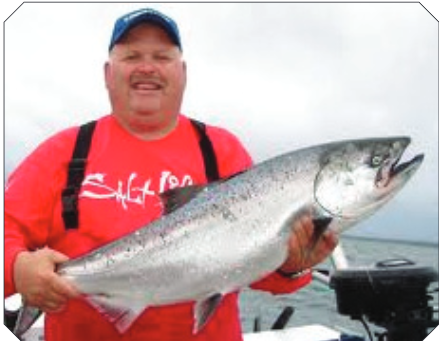
“Spinfishing” for Puget Sound Blackmouth |
| By Captain John Keizer So how do you find Puget Sound winter blackmouth? The answer is don’t look for the blackmouth but rather look for what attracts blackmouth. Blackmouth are a delayed released hatchery king salmon that don’t migrate to Alaska but instead inhabits the waters of Puget Sound after being released. The name blackmouth comes from the black gumline that identifies it as a resident chinook salmon. Blackmouth range from the legal size of 22 inches up to fish taken in the upper teens. In the many years I have fished Puget Sound I have found that Puget Sound blackmouth relate to three things, structure, current and food.We have all heard the line, “Find the bait-find the fish.” It sounds so easy but so many anglers ignore this simple advice in locating blackmouth. Blackmouth salmon are voracious feeders and will be looking for sand lance (candlefish) or herring to fill their bellies year around in Puget Sound. The sand lance, which are also known locally as “candlefish,” because pioneers used to dry them and make candles out of them due to their high oil content are an ecologically important forage fish throughout Puget Sound where they school in many bays, banks and inlets. Sand lance are important food for young salmon who crave the high oil content; 35% of juvenile salmon diets are composed of sand lance and blackmouth salmon depend on sand lance for 60% of their diet. Sand lance spawning occurs at high tide in shallow water on sand-gravel beaches. Sand lance will also use sandy beaches for spawning. Knowing when and where this food source is will directly reflect on locating winter blackmouth. Herring can be located at resting spots that are dictated by the current. As in river fishing, bait will be pushed into the lee of a current flow behind points, islands and land masses. The same is true in Puget Sound, knowing the position of the tide will allow you to find the best location to find baitfish and salmon feeding on it. Trolling a downrigger is in my opinion the best method for consistently hooking blackmouth. I spend much of the winter season employing this method of fishing. I run 3 Hi Performance Scotty 2106 downriggers onboard Salt Patrol my 27ft North River O/S. Being able to cover lots of water with your tackle at a controlled depth is an extremely effective way to fish for winter chinook that like to inhabit the deep waters of Puget Sound. My rod & reel setup is a Shimano Tekota-A 600 Line counter reel matched with a G. Loomis E6X 1265 moderate action rod. The reels are spooled up with 30-pound test mono main line. Yes, downrigger fishing is the one fishery that I still run mono line for. New from Yakima Bait is the Spinfish bait-holding lure, representing a new design in combining lure-and-bait to produce more and bigger salmon. The SpinFish features a pull-apart fillable bait chamber with a scent-dispersing design. When trolled behind a downrigger this lure will produce a vibrating, spinning, wounded-baitfish action that salmon can’t resist. Yakima SpinfishI was lucky to get to test the prototypes for the Spinfish last winter. My first experience with the Spinfish started with targeting winter blackmouth out of Port Townsend located on the northern part of Puget Sound. We ran the Spinfish behind 11” rotating flashers and medium size Fish Flash and had very good success on blackmouth up into the mid-teens. The strike on the Spinfish is not like on light tap on a bait bite. The blackmouth will hit the Spinfish hard, run a bunch of line out of the reel and then race to the surface for the rest of the fight. Several times the rod tip would be in the water when we went to take the rod out of the holder. To ready the Spinfish you just pull apart the body and fill with any bait including tuna, herring or sardines. I had the best results using canned Chicken of the Sea Tuna (packed in oil). Pour the canned tuna into a plastic container with the all the oil in the can. At this point I will add scents from Pro-Cure. Mix in some Bloody Tuna or your choice scent and mix and you’re ready to charge the Spinfish body. Pack the Spinfish body with tuna and put the two parts back together. I rig my Spinfish 25-40 inches behind a Fish Flash or 35-45 inches behind rotating flashers. My setup last year was to tie two 4/0 Mustad octopus hooks close together on 30lb Seaguar fluorocarbon leader and add one glow bead above the top hook to act as a ball bearing. Slide the Spinfish on the leader and tie to swivel and then attach to the Fish Flash or rotating flasher and you’re ready to fish.Yakima Fish FlashThe SpinFish can be rigged to spin clockwise or counterclockwise and unlike other bait holding lures, it needs no rubber bands to keep the lure together. The precisely drilled sent holes in the Spinfish will disperse a sent pattern into the water and salmon will follow the scent trail back to the lure. Just like any lure bring your gear up every 20 minutes and check it for shakers (undersize salmon) and re-charge the Spinfish body with fresh tuna. I normally have 4-5 Spinfish loaded with different bait scents and ready to swap out each time I check my gear. Blackmouth bites windows are short and you don’t want to waste time during the prime bite times rigging tackle. The new SpinFish comes in two sizes, a three inch and a four-inch version, that now both come fully rigged and ready to fish. The three-inch size comes in 20 of the hottest colors Yakima Bait producers. The four-inch version comes in 10 proven fish-attracting colors. All the Spinfish colors are coated in UV blackmouth catching finishes. Blackmouth like to do their feeding where the bait is. They are aggressive feeders and tend to feed when the current is minimal to expend as little energy as possible. That means the best time to catch them is when you’re fishing in the right current flow or lack of current movement. You may have heard that the best fishing for blackmouth is one to two hours before or after a tide change. Really its right before or right after a current change as that’s when the water goes slack and the fish will expend the least energy finding baitfish. |